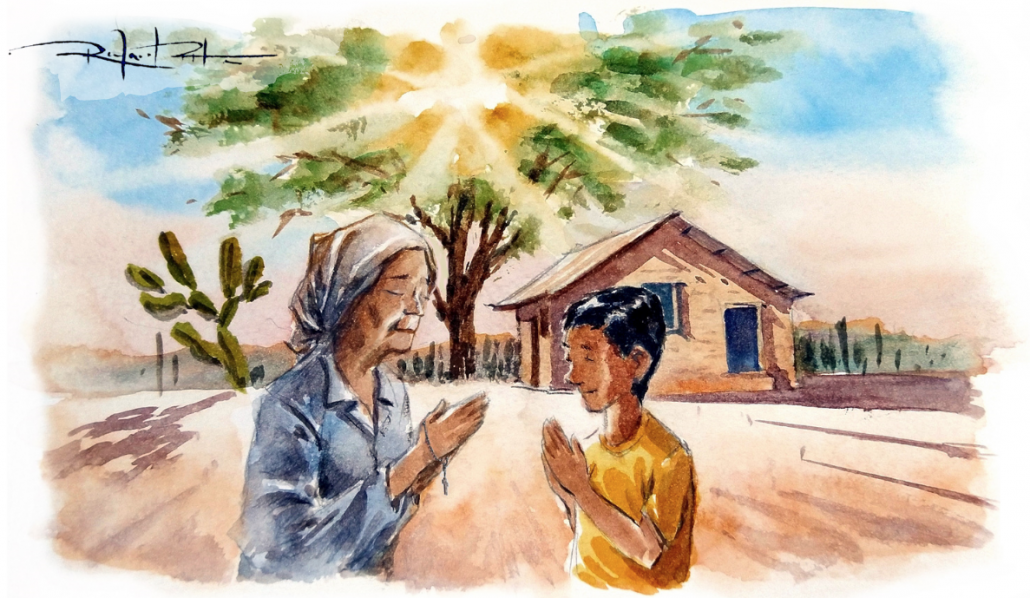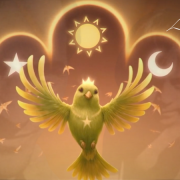| January 27, 2022
Giving continuity to contents in commemoration of the centennial of the birth of Mestre Gabriel (to be celebrated on the upcoming February 10th), the UDV blog publishes today a text written in 2013. In it, the author presents the environment in which José Gabriel da Costa was born and spent his childhood and youth, marked by the Brazilian northeastern religiosity and culture.
Edson Lodi*
Many days have already passed since the small village of Coração de Maria received Manoel Gabriel da Costa and Prima Feliciana, who, in turn, cared for their children, among them José Gabriel da Costa. A boy who made himself man, master of himself and of so many others, nourishing his memory with the Brazilian northeastern religiosity and culture of a small Bahian village, between the Atlantic Forest and the caatinga1, in the heart of the sertão (countryside). From there he made himself a citizen of the world.
A region close to the recôncavo baiano2, its first inhabitants were the Paiaás Indians, belonging to the great Tupi nation, who over time mingled with fugitive slaves and the Portuguese remnants of colonization and the Jesuit Missions; thus forming the dense and very rich cultural spring in which the boy José shaped his talents, his gifts and his spiritual mission.
The relentless sun scorched the earth and life was hard as stones, distilled in the sweat of the inhabitants when planting cassava, corn, beans and tobacco. From cassava, flour was made; the main source of food for the inhabitants of the region. Tending to cattle and sheep also required daily care.
The town of Retiro, where Fazenda Pedra Nova (New Rock Farm) was located, also suffered the rigors of the great drought that devastated Bahia in 1932. This event marked the memory of Antônio Gabriel da Costa, one of the couple’s sons. The sweetest description of the first time that the image of his brother, José Gabriel, is rescued by his memory refers to José Gabriel accompanying his father, bringing the precious food – cassava.
Music, which permeated the families’ daily lives, was used to ask Saint John the Baptist for mercy. They begged that the water would fertilize the countryside and the hopeful hearts of the people of the sertão:
“Saint John if he well knew / when it was his day / would descend from heaven to earth / with pleasure and with joy. / In that deep source / where Saint John bathed / there were so many diamonds / that the angels shine brilliantly. / I offer this benediction / to Lord Saint John / who frees us from this drought / forever, amen, Jesus (…)”.
Mr. Manuel Gabriel, Mrs. Prima Feliciana and their children – just like other sertanejo families – kept faith in their roots and their breath to endure the hardships of their lives, dry as the stones and the dust of the ground.
On the 27th of September, the day of the saints of Dona Prima’s devotion, the rustic voices in tune with living simply sang the Prayer of São Cosme and São Damião (Saint Cosmas and Saint Damian). Brown and black hands clapped rhythmically, accompanying the Prayer. The mooing of the cattle in the corral, the bleating of the sheep and the songs of the nocturnal birds were part of the musical fabric, of prayers that rose to the star-studded sky, where the moon reigned sovereign and gentle.
Feet shod in leather sandals step on a packed earth floor. On the wall of the room painted with whitewash, images of saints. They are photographs faded by time and by faithful gazes, which they felt renewing their hopes just by looking at contours. On a small wooden table, there was the old oratory, a small altar also made of wood, with doors always open during times of prayer.
Aunt Rosa’s voice sings the Prayer of the holy boys with devotion. She is accompanied by José Gabriel, who sings a second voice. Aunt Rosa looks at that boy with the eyes of someone who sees the gentle rain brightening the sky of the sertão in the new bloom of flowers. “José is the string of my heart” – she would say.
Crystaline words: the string of my heart. A feeling so clear that tied her to her nephew, so young still in the things of heaven. She already loved him who, among so many gifts, already unveiled one: that of loving and making himself loved, holding hearts in captive bonds of cherishing. And in these bonds of love untied from any fantasy or egoism, his mission was already foreshadowed, clarifying…
Some time later, Mestre Gabriel clothes with clear and spiritually attuned words the simple sentiment of the Prayer, and brings it to the Salon of the Vegetal in the form of a chamada.
The work on the farm and with the animals they raised, to help make a living, was arduous and continuous – but constant also was the honey of joy. The tasks, performed without the aid of machinery, were repetitive and took a long time. To lessen the fatigue and give energy to the toil, they sang work songs – the bean shucking songs, the flour house songs, the yard chulas3, aboios (cattle calls) and so many others. Again, music filled in the spaces.
On festive days or at the end of the work parties – when the families got together – the beat of the songs were changed. New joys and harmonies were awakened in the sounds generated by instruments made by those hands, calloused by working with the land, with animals, but softened in the affection towards the beloved woman. Then, sambas, banter and so many other merriments were made. José Gabriel, along with his brothers, played in boyish joy.
To what extent the northeastern and very Brazilian culture leaves its mark on the work that José Gabriel da Costa recreated in recordation and love? I think there are no instruments to measure it, except for the heart that beats strong, pregnant with longing for something that was not yet lived.
The chants, the games, the songs of devotion and work. The caboclo language of that sertão of my God. The knowledge, the affections, the hopes, the works and the fortune. The singing of birds, the sounds of uncouth instruments, the fibers of so many hearts – everything remained in the memory of the boy, the man, of Mestre Gabriel.
And he generously comes to offer this treasure, added with delicate diamonds of very fine light, so simple – the movement of a nhambu bird when collecting the drops of dewy water on the verdant tips of the grass to quench its thirst.
–
*Edson Lodi is member of the Cadre of Mestres of UDV and of the Council of the General Administration of the Beneficent Spiritist Center União do Vegetal.
–
1Type of subtropical vegetation, and an ecoregion characterized by this arid-adapted vegetation in interior northeastern Brazil. The name “Caatinga” is a Tupi word meaning “white forest” or “white vegetation” (caa = forest, vegetation, tinga = white).
2 A geographic region around the Bay of All Saints, which includes the metropolitan area of Salvador, Bahia.
3A traditional music genre, of African origin.
 English
English Português
Português Español
Español




Leave a Reply
Want to join the discussion?Feel free to contribute!